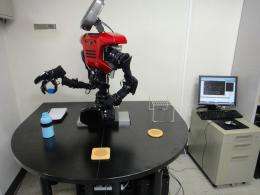August 2, 2011 weblog
Researchers give robot ability to learn (w/ Video)

Researchers with the Hasegawa Group at the Tokyo Institute of Technology have created a robot that is capable of applying learned concepts to perform new tasks. Using a type of self-replicating neural technology they call the Self-Organizing Incremental Neural Network (SOINN), the team has released a video demonstrating the robot’s ability to understand it’s environment and to carry out instructions that it previously didn’t know how to do.
The robot, apparently not named because it’s not the robot itself that is being demonstrated, but the neural technology behind what it’s able to achieve, is capable of figuring out what to do next in a given situation by storing information in a network constructed to mimic the human brain.
For example, the team demonstrates its technology by asking the robot to fill a cup with water from a bottle, which it does quite quickly and ably. This part is nothing new, the robot is simply following predefined instructions. On the next go round however, the robot is asked to cool the beverage while in the middle of carrying out the same instructions as before. This time, the robot has to pause to consider what it must do to carry out this new request. It immediately sees that it cannot carry out the new request under the current circumstances because both of its hands are already being used (one to hold the cup, the other the bottle) so, it sets the bottle down then reaches over to retrieve an ice cube which it promptly deposits in the cup.
This little demonstration, while not all that exciting to watch, represents a true leap forward in robotics technology and programming. Being able to learn means that the robot can be programmed with just a very basic set of pre-knowledge that is then built upon for as long as the robot exists, without additional programming; not unlike how human beings start out with very little information at birth and build upon what they know and are able to do over a lifetime. The robot has an advantage though, because not only is it able to learn from its own experiences, but from others as well all over the world. This is because it can be connected to the internet where it can research how to do things, just as we humans already do. But, in addition to that it could conceivably also learn from other robots just like it that have already learned how to do the thing that needs doing.
As an example, one of the research team members describes a situation where a robot is given to an elderly man as a nurse and is then asked to make him some tea. If the robot doesn’t know how, it could just ask another robot online who does. Remarkably, the first robot could do so even if he (it) is trying to make English tea and the robot who answers the internet query has made only Japanese tea before. The lessons the first robot has learned over time would allow him to adapt, and that’s why this breakthrough is so important, because it means given enough time and experience, robots may soon finally be able to do all those things we’ve been watching them do in science fiction movies, and likely, more.
Via diginfo.tv
More information: haselab.info/pbai-e.html
© 2010 PhysOrg.com



















